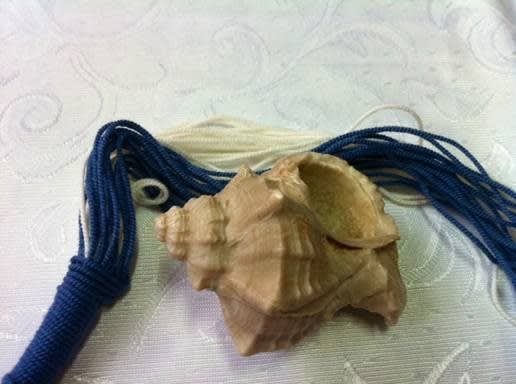“Meaning in Mitzvot” generally discusses only mitzvot that are practically carried out in our day. Today we will discuss a mitzva that many, though not most, authorities believe that we can try to fulfill: the mitzva of a tekhelet thread on the tzitzit. Let us see what our tradition tells us about this commandment. (see last week’s TT, specifically the Meet Murex Trunculus piece for a very different presentation of this mitzva)
In Scripture, tekhelet in garments is often identified with wealth and royalty. Yirmiyahu counts it along with silver and gold among the treasures of the world (Yirmiyahu 10:9), while Mordechai’s ascent to power is marked by his wearing tekhelet garments (Esther 8:15).
The Talmud also emphasizes its expense. One Midrash compares the white threads to a clay vessel and the tekhelet ones to gold (Yalkut Shimoni Shelach).
Yet regarding the mitzva of tekhelet, we find the exact opposite theme: in several places we find it connected to modesty and simplicity. For example, the Talmud tells us that the Jewish people merited the thread of tekhelet because of Avram’s refusal (Bereshit 14:23) to accept even a shoelace from the King of Sodom (Sota 17a).
And our Sages tell us that the story of Korach immediately follows the mitzva of tekhelet to hint to us that the wealthy Korach rejected this commandment. “Rav said, Korach was immensely wealthy; Pharaoh’s treasure was exposed to him between Migdol and the sea. Rav said, Korach was a denier; he made a talit which was entirely tekhelet, and came to Moshe. He asked, is a talit which is entirely tekhelet obligated in tzitzit? He said, it is obligated” (Yerushalmi Sanhedrin 10:1).
Korach claimed to be a democrat, complaining that Moshe and Aharon raised themselves up above the common people. But in reality he was a plutocrat; we see in his claims that money should be able to substitute for mitzvot.
The average person could never afford a talit dyed throughout with tekhelet, but Korach could and his claim was that this should exempt him from the mitzva of tekhelet.
We can discern a similar paradox in the gemara in Sota. The passage continues by asking, what is so special about the mitzva of tekhelet ? The answer is that the tekhelet resembles the sea, which resembles the firmament, which resembles G-d’s Seat of Glory. “And they saw the G-d of Israel, and under His feet was the likeness of bricks of saphire, pure like the essence of the sky.” (Shemot 24:10) This was the vision of the leaders of Israel who approached Har Sinai together with Moshe and Aharon. The Torah then tells us that they were worthy of punishment for their behavior when seeing this vision; Rashi explains that they related to this vision as something familiar, without the appropriate awe.
We can understand this in a similar fashion. The bricks of sapphire seem to represent wealth, something which would have been familiar to the princes of Israel. But Rashi explains that they actually represent the crushing labor of Jewish slaves in Egypt who struggled to make their daily toll of bricks.
To Korach, tekhelet symbolized wealth; it also reminds us of the heavenly firmament, which may also seem to represent wealth. But Chazal show that there is an exact opposite symbolism of simplicity and equality. Even a tekhelet which is all tekhelet is forbidden if it doesn’t have the same single strand of tekhelet which exempts a simple person’s garment. And it was Avram’s lack of greed which brought us this mitzva, which reminds us of the Throne of Glory which surveys not only the “purity of the sky” but also the crushing labor of simple people.
It is precisely the single thread of priceless tekhelet which reminds us that each Jew has before G-d a status like kings and princes, which money can never buy. The Torah explicitly tells us that the tzitzit reminds us of all the commandments; and indeed, it is the sanctity of the commandments which gives us our unique status.
May it be His will to reveal to us soon, by natural or miraculous means, the certain way to perform this important mitzva so that we may all bear this important reminder of the entire Torah.
Rabbi Asher Meir is the author of the book Meaning in Mitzvot, distributed by Feldheim. The book provides insights into the inner meaning of our daily practices, following the order of the 221 chapters of the Kitzur Shulchan Aruch.
The words of this author reflect his/her own opinions and do not necessarily represent the official position of the Orthodox Union.
